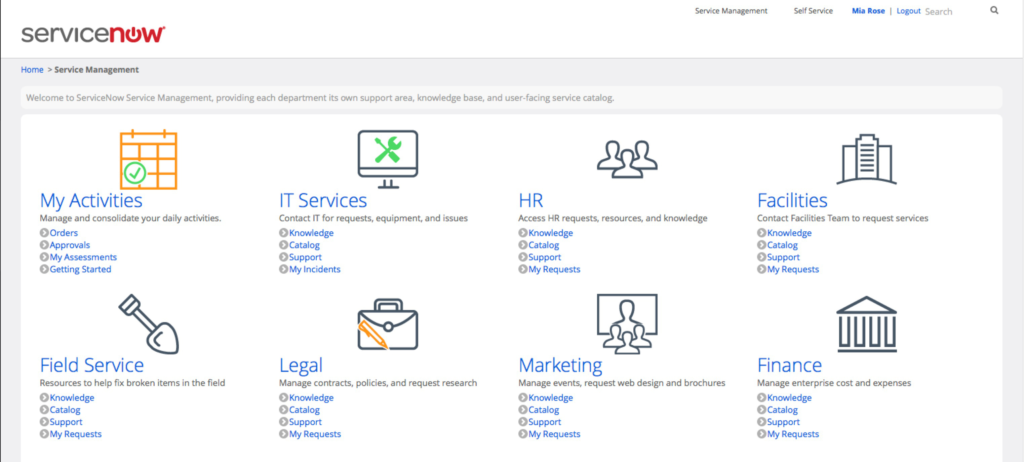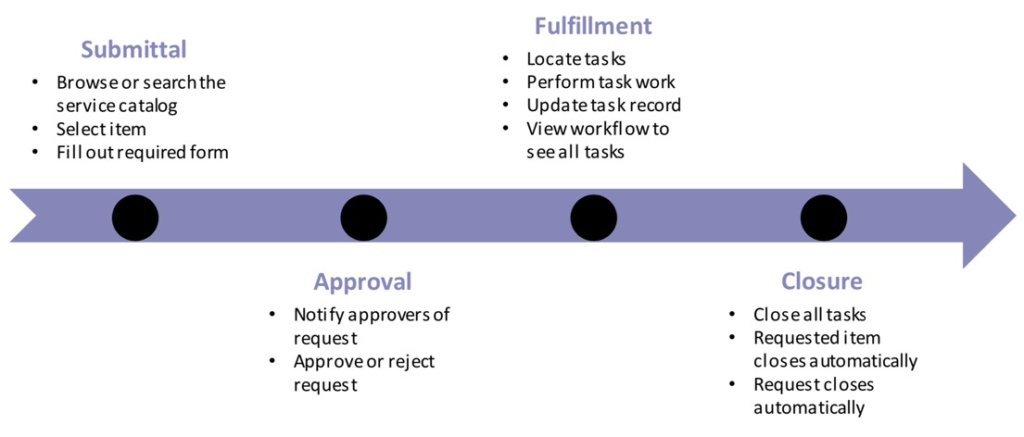Enhancing User Service Requests
Enhancing User Service Requests: A Guide for Business Service Owners in ServiceNow. As a pivotal figure in service delivery, Business Service Owners hold the key to seamless operations and top-notch user experiences. This comprehensive guide empowers you with best practices to craft a workflow that maximizes User Service Requests fulfillment within ServiceNow.
Set Clear Workflow Objectives: Enhancing User Service Requests
Begin by gaining a crystal-clear understanding of the workflow’s intended outcomes. Factor in elements such as swift response times, heightened user satisfaction, and resource optimization.

Identify Crucial Stakeholders
Objective: Engage with all pertinent stakeholders in the service request fulfillment process. This encompasses IT teams, HR, Facilities, and more. Collaboration with these parties is essential in grasping their requirements and expectations.
- Who actively utilizes the ITSM Service Catalog as primary end-users?
- Which departments or teams will be the main users of the Service Catalog?
- Who holds the authority to approve and manage services listed in the Service Catalog, and are there specific compliance or regulatory bodies that need to be consulted?
- Are there any external vendors or service providers that play a crucial role in defining services?
- Are there specific user groups or personas with distinct service needs that should be taken into account?
- What expectations and requirements do stakeholders from the IT department have in terms of service offerings?
- Are there specific metrics or KPIs that stakeholders would like to see associated with services?
- Are there budgetary constraints or financial stakeholders influencing the catalog’s services?
- Is there an internal governance or steering committee that actively oversees the Service Catalog?
- How do stakeholders prefer to receive communication and updates regarding the Service Catalog?
- Have stakeholders experienced specific historical pain points or challenges with the previous Service Catalog (if applicable)?
- Are there any future business initiatives or projects that may potentially impact or influence the Service Catalog’s offerings?
Visualize the Workflow
Objective: Render the workflow as a visual masterpiece, delineating every step from request submission to resolution. Define critical decision points, approval pathways, and escalation protocols, if needed.

- How does a user initiate a service request through the Service Catalog?
- What steps are involved in processing and fulfilling a service request once it is submitted?
- Are there specific approval processes or workflows that need to be followed for certain service items?
- How are service items categorized and organized within the Service Catalog for easy navigation and selection by users?
- What are the escalation procedures in case a service request encounters delays or issues during fulfillment?
Next Engage ServiceNow’s Workflow Designer
Objective: Master ServiceNow’s Workflow Designer, your canvas for visualizing, documenting, and automating the workflow. Consider seamless integration with other ServiceNow applications and modules for enhanced efficiency.
Identify Trigger Mechanisms
Objective: Pinpoint the triggers that set the workflow into motion. Whether it’s a user-initiated service request, a specific event, or a scheduled task, tailor trigger conditions to match the workflow’s rhythm.
Identifying trigger mechanisms in the Service Catalog Service Desk involves a systematic approach. Here are the steps and questions you need to consider:
Trigger Steps:
- Review Service Catalog Offerings:
- Start by examining the list of services offered in the Service Catalog.
- Analyze Service Request Scenarios:
- Consider different scenarios in which users might need to make a service request.
- Identify Key Events:
- Pinpoint events or actions that initiate service requests.
- Define Trigger Conditions:
- Specify the conditions that must be met for a trigger to activate a service request.
- Document and Test Triggers:
- Document the identified triggers and conduct tests to ensure they function as intended.
- Monitor and Refine:
- Regularly review and refine trigger mechanisms to adapt to changing business needs.
Trigger Questions to Ask:
- What Actions Prompt a Service Request?
- Identify the specific actions or events that lead users to submit service requests.
- Are There Time-Based Triggers?
- Consider if there are time-specific triggers, such as scheduled maintenance or routine checks.
- Do System Alerts Play a Role?
- Determine if system-generated alerts or notifications can trigger service requests.
- Are There Thresholds or Limits to Consider?
- Ask if certain thresholds or limits need to be met for a service request to be triggered.
- What Data or Information Initiates Requests?
- Determine if specific data inputs or information trigger service requests.
- Are External Triggers Possible?
- Consider if external factors, such as API calls or integrations, can trigger service requests.
- Do Events in Other ITSM Processes Trigger Requests?
- Explore if events in other ITSM processes, like incident management, can initiate service requests.
- Are Business Rules Involved in Triggering Requests?
- Inquire if defined business rules within the Service Catalog play a role in triggering service requests.
- How Can Triggers Be Configured and Customized?
- Understand the configuration options available for setting up trigger mechanisms.
- What Is the Escalation Process for Triggered Requests?
- Establish how triggered requests are escalated and managed for timely resolution.
Establish Approval Procedures
Objective: Tailor approval steps based on the unique nature of each service request. Leverage ServiceNow’s approval workflows to automate this process, ensuring swift and accurate approvals.
Deploy Proactive Notifications
Objective: Keep users in the loop regarding the progress of their service request. Configure automated email notifications to deliver timely updates at pivotal junctures in the workflow.

Define SLAs and Escalation Protocols
Objective: Define Service Level Agreements (SLAs) for every step in the workflow. Additionally, put in place escalation protocols for requests that surpass defined SLAs, guaranteeing a prompt resolution.
Rigorous Workflow Testing
Objective: Rigorously test the workflow to ensure seamless functionality. Scrutinize trigger conditions, approval processes, notifications, and escalations to guarantee smooth operation.
Documentation and Continuous Improvements for Enhancing User Service Requests
Objective: Document the workflow comprehensively, encompassing its purpose, steps, and designated responsible parties. Extend training to relevant teams, equipping them to wield and manage the workflow with precision.
Continuous Monitoring and Optimization
Objective: Employ ServiceNow’s robust reporting and analytics tools to vigilantly monitor the workflow’s performance. Collect feedback from users and stakeholders to pinpoint areas for enhancement.
Conclusion: Success is in Enhancing User Service Requests
By adhering to these best practices, you’ll craft a streamlined workflow that elevates the employee experience and ensures the prompt fulfillment of User Service Requests within ServiceNow. Regularly revisit and refine the workflow to adapt to evolving business needs.
Remember, as a Business Service Owner, you wield substantial influence in guaranteeing seamless service delivery. This finely tuned workflow is your cornerstone for success.
Resources for Enhancing User Service Requests
- Agent Workspace for Request Management (servicenow.com)
- One-IT: Effective Ticket Handling
- Employee Service Management (servicenow.com)
- ITIL 4, Part 2: The Guiding Principles (thinkhdi.com)
- Journey designer (servicenow.com)
- Productivity: Service Operations Workspace
- Service Catalog – ServiceNow
- Service Portal (servicenow.com)
- Ticket Handling Infographic FAQs
- Virtual-Agent Chatbot

-
Getting Started
- AI: ServiceNow Virtual-Agent Chatbot
- BMC Remedy ITSM Reference
- Burp Suite Professional & Web Security Process
- COE for Human Resources
- Conduct A Windows-Security Scan
- Employee Journey Management ServiceNow
- Getting Started: Engagement Manager
- Introduction to Knowledge Management
- Knowledge Categorization "Find-ability"
- One-IT: Effective Ticket Handling
- Productivity Tips for Knowledge-Users
- Productivity: Service Operations Workspace
- Quick Start Guide
- Service Catalog Order Guides
- Your Next Steps
-
- Advanced Program Management
- AI: ServiceNow Virtual-Agent Chatbot
- Artificial Intelligence A-Z Glossary
- Business Process Optimization Reviews
- Category Hierarchy and Tabs Layout
- Employee Journey Management ServiceNow
- GE Change Acceleration Process
- GRC Managed Risk
- Overview: Employee Center Pro
- Productivity: Service Operations Workspace
- Proper Ticket Handling Imperative
- Public Sector Digital Services
- RIDAC: Strategic Portfolio Management
- SOX Control-Management and Attestation
-
- Articles coming soon
-
FAQs
- Best of ServiceNow Vancouver
- Chat GPT FAQS
- DevOps & Change Velocity
- Enhancing End-User Service Experience
- FAQs: Governance Risk Compliance
- How-To Import ServiceNow Stories 🚀
- Knowledge Categorization "Find-ability"
- Role of CMDB-Management Service-Owner
- Service Catalog Process FAQs
- ServiceNow IRM SOX FAQs
- Strategic Portfolio Management FAQs
- Ticket Handling Infographic FAQs
- Understanding Clop Ransomware Mitigation
- Vulnerability Response Workspace Module
- Washington ESC or Knowledge Portal?
-
- AI & GRC Defense Against Security-Data Breach
- AI and Improved Knowledgebase-Search
- AI Revolutionizes Service Management
- AutomatePro AutoTest Custom-Testing
- AutomatePro AutoTest: Getting Started
- Best of ServiceNow Vancouver
- CMDB Health Dashboard
- Comparing ServiceNow-Strategic-PM to Microsoft-PM
- Demystifying Taxonomy Categorization
- DevOps & Change Velocity
- Efficient Workday to ServiceNow Integration
- Email-to-Incident is Costly Inefficiency
- Enhancing End-User Service Experience
- Financial Services Operations
- Gamifying ITSM Excellence
- GRC Industry Reference Matrix
- Introducing Security Incident Response
- Role of CMDB-Management Service-Owner
- Service Catalog Process FAQs
- ServiceNow Executive Reporting Approaches
- ServiceNow Virtual Agent Chatbot
- SPM Gantt Chart Presentation
- Strategic Portfolio Management FAQs
- Vulnerability Response Test Plan
- Vulnerability Response Workspace Module
- Washington ESC or Knowledge Portal?
- Show Remaining Articles11 Collapse Articles
-
Glossary Reference
-
Blog
- 2021: VP Harris Inauguration Elevates Diversity and Executive Leadership
- 5-Star ITSM Solutions
- 5-Step Policy-Compliance Risk Management
- AI & GRC Defense Against Security-Data Breach
- AI Revolutionizes Service Management
- AI: Knowledge Centered Support
- ChatGPT Ethics and FTC
- CMDB Corporate Governance for Publicly Held Companies
- Community Crisis Resource Reference List
- Covid Cyber Employment Fraud: $Millions in Job Fraud, $Billions in Unemployment Fraud. Recruiters and Jobseekers Paradigm shift
- Does Post Covid Demand, "Evolve or Fold" Data Strategy?
- Financial Services Operations
- Freshwork's Multichannel vision for FreshService (ITSM)
- Gamifying ITSM Excellence
- GRC Industry Reference Matrix
- Imperative: Governance Risk Compliance
- Jobs n Career Success: Employment News
- Microsoft Teams Tripping Transcription Tenancy.
- Predictive Intelligent Situational Awareness
- Remedy to ServiceNow Migration
- Review and Approve Knowledge
- ROI: Demand AI Service Management
- Top Trends in Project Management
- Uber's Call Center Security Social Engineering Massive System Breach
- Vulnerability Remediation RACI
- Walk Up Experience- Design-To-Deliver
- World Talent Economy Forum on Global Competitiveness
- Show Remaining Articles12 Collapse Articles
-
Healthcare
-
Workday
-
Network Connectivity Solutions
-
Business Process Methodologies

